Of Pancit Alanganin, Sinuso, Dinuguan and Putong Polo
“Tito, alam mo ba ang alanganing pancit? “A friend asked me while we were having dinner at her mom’s house. My spoon stopped in midair, like in suspended animation, my left eyebrow arched sky high on its own. She burst into laughter, seeing my reaction.
I know there is baklang alimango but baklang pancit? Come on! (There was no baklang alimango until some Dummkopft thought it funny – funnymyass – to call it so. Baklang alimango was known as luno when I was growing up, apparently because of its inherent characteristic – soft-shelled, hence luno (soft, weak). A bakla is supposed to be luno, weak. Those who define bakla as such may visit a leather gay bar for the surprise of their life. If you are one of them, don’t forget to carry a lub with you should you get lost in the darkroom. You may be in for a rough ride which can make you think twice before you say bakla next time you see a soft-shelled alimango.*
“You can also have Sinuso, “that was my friend again, at the dining table. I think I choked.
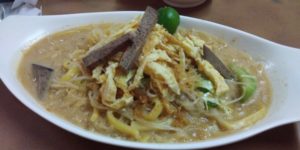
Pancit Alanganin is a mix of egg noodles, and bihon (rice noodles) stewed with a bit of milk, which makes it soupy as opposed to your regular pancit bihon cooked to a dry consistency. It is neither this nor that; hence, alanganin – undeniably not al dente; it was soft and soggy.
My friend wanted to introduce me to this pancit. It is very famous in Bocaue, a town in my province, that people from neighboring towns drive even in soaring temperatures to this eatery, which the owner confidently calls a restaurant. It was super hot that day we had our food trip. The restaurant was in the silong ( ground floor or under the house) and crowded with guests despite the unbearable heat. Two ceiling fans were blowing hot air. The resto may have started as a canteen catering to students from a nearby private school. It was probably the only place considered “cool “at that time for young students to meet with their peers during class breaks, or even after school while waiting for their yayas or the chauffeur-driven family car.
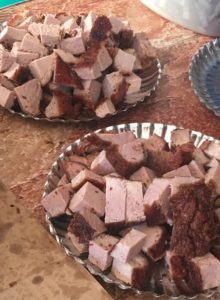
Chopped sinuso
Sinuso is a deep-fried mammary gland – pig’s mammary gland. Suso is Tagalog for tits while Sinuso is the past tense for the suckling act. Gross graphic description, I know, but since when is suckling tits considered gross? The day you stopped being an infant? I know that many men, as well as women, never quit.
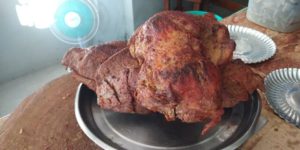
Sinuso (Deep-friend mammary gland)
My friend bought 2 kg of Sinuso. Fry them, that was how I remember my Dad liked them, she suggested. Good for breakfast, her mom told me. I went home with my share of Sinuso. Breakfast time and I had a spoonful of them – and stopped after a spoonful. No more fried mammary gland in fried rice for me, please. Must have been my imagination. Wyatt, my transient boarder, liked Sinuso. Again, I say different strokes for different folks.
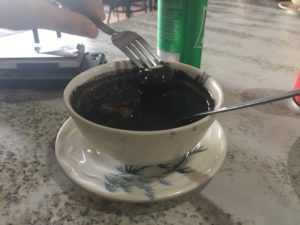
Dinuguan (Pork blood stew)
“We’ll have dinuguan in Marilao. Very good with their putong polo. “That was my friend again, her eyes glowing with animation, talking about our next stop. Marilao is another town in Bulacan, next to Bocaue, if you are south-bound. It was our next stop – another restaurant/carinderia, offering the best blood stew in town and equally famous for its rice cakes called putong polo. Polo, now Valenzuela City, shares border with Marilao, and the claim to fame to Putong Polo.
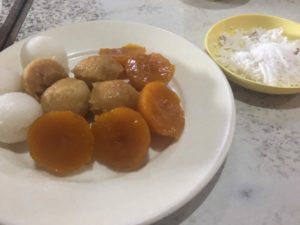
Putong Polo (rice cakes named after the town which made them famous)
“I can have the puto, you can have the dinuguan, “I wanted to say. Dinuguan is not suitable for people with high uric acid. I am one of those people. I was not risking another gout attack eating dinuguan. I had pancit palabok instead, another kind of dish noodles with shrimp gravy. Even this could trigger a gout attack, but I was taking the risk. In the end, I could not resist soaking my puto in the blood stew. I woke up the next day feeling the pain in my left foot. Oh, the beautiful things I can live without! Never mind, who cares anyway for dinuguan on a sizzling day like that day in a carinderia/resto in flame? I can try again in December.
——————–
* I made the wrong description of Baklang Alimango. A good friend, a foodie, brought to my attention that soft-shelled alimango (luno) and Baklang Alimango are two different crabs. “The baklang alimango is more fleshy, with yellowish taba (fat). The shape of the “apron” or flap is a characteristic that is between patusok (pointed) and malapad (wide).” As in true Beki (gay lingo for bakla) fashion, the baklang alimango must stand out from the crowd, generally very particular about its physical appearance, loves perfection.

My friends and I doing the food trip
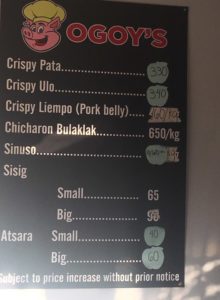
The permanent menu
Please bring some putong polo Dik. Puti and brown. I miss those. But these days they make them very small. Perfect with butter!
They make them very small, correct. Will bring you some para maging super cindy ka na uli :)